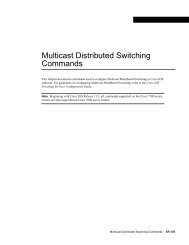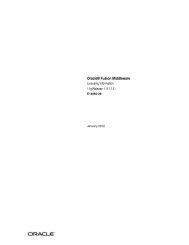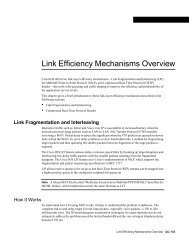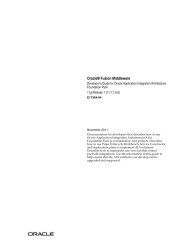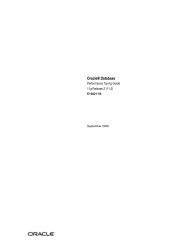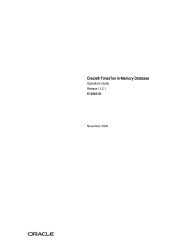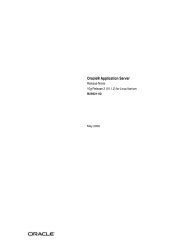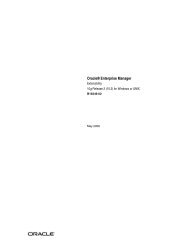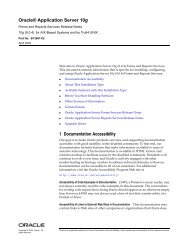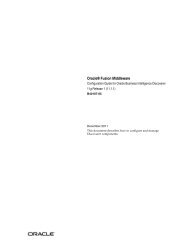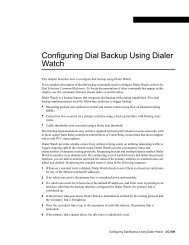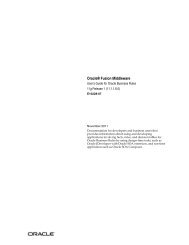Configuring 1- and 2-Port T1/E1 Multiflex Voice/WAN ... - docs.mind.ru
Configuring 1- and 2-Port T1/E1 Multiflex Voice/WAN ... - docs.mind.ru
Configuring 1- and 2-Port T1/E1 Multiflex Voice/WAN ... - docs.mind.ru
You also want an ePaper? Increase the reach of your titles
YUMPU automatically turns print PDFs into web optimized ePapers that Google loves.
Glossary<br />
Glossary<br />
AMI—alternate mark inversion. Line-code type used on <strong>T1</strong> <strong>and</strong> <strong>E1</strong> circuits. In AMI, zeros are<br />
represented by 01 during each bit cell, <strong>and</strong> ones are represented by 11 or 00, alternately, during each<br />
bit cell. AMI requires that the sending device maintain ones density, which is not maintained<br />
independent of the data stream. Sometimes called binary coded alternate mark inversion.<br />
ATM—Asynchronous Transfer Mode. International st<strong>and</strong>ard for cell relay where multiple service<br />
types (such as voice, video, or data) are conveyed in fixed-length (53-byte) cells that allow cell<br />
processing to occur in hardware; thereby transit delays are reduced. ATM is designed to take<br />
advantage of high-speed transmission media such as E3, SONET, <strong>and</strong> T3.<br />
B8ZS—binary 8-zero substitution. Line-code type, used on <strong>T1</strong> <strong>and</strong> <strong>E1</strong> circuits, in which a special<br />
code is substituted whenever 8 consecutive zeros are sent over the link. This code is then interpreted<br />
at the remote end of the connection. This technique guarantees that ones density is independent of<br />
the data stream.<br />
CAS—channel-associated signaling. T<strong>ru</strong>nk signaling (for example, in a <strong>T1</strong> line) in which control<br />
signals, such as those for synchronizing <strong>and</strong> bounding frames, are carried in the same channel along<br />
with voice <strong>and</strong> data signals.<br />
CCS—common channel signaling. T<strong>ru</strong>nk signaling (for example, using Primary Rate Interface) in<br />
which a control channel carries signaling for separate voice <strong>and</strong> data channels.<br />
CO—central office. Local telephone company office where all local loops in a given area connect<br />
<strong>and</strong> circuit switching of subscriber lines occurs.<br />
codec—Coder-decoder. Device that typically uses pulse code modulation to transform analog<br />
signals into a digital bit stream <strong>and</strong> digital signals back into analog.<br />
DTMF—Dual-tone multifrequency. Use of two simultaneous voice-b<strong>and</strong> tones for dialing (such as<br />
touch tone).<br />
Drop <strong>and</strong> Insert—(also called TDM Cross-Connect) Allows DSO channels from one <strong>T1</strong> or <strong>E1</strong><br />
facility to be digitally cross-connected to DS0 channels on another <strong>T1</strong> or <strong>E1</strong>. By using this method,<br />
channel traffic is sent between a PBX <strong>and</strong> CO PSTN switch or other telephony device, so that some<br />
PBX channels are directed for long-distance service through the PSTN while the router compresses<br />
others for interoffice VoIP calls. In addition, Drop <strong>and</strong> Insert can cross-connect a telephony switch<br />
(from the CO or PSTN) to a channel bank for external analog connectivity.<br />
DSP—digital signal processor.<br />
<strong>E1</strong>—European digital carrier facility used for transmitting data through the telephone hierarchy. The<br />
transmission rate for <strong>E1</strong> is 2.048 megabits per second (Mbps).<br />
E&M—rEceive <strong>and</strong> transMit, or Ear <strong>and</strong> Mouth. Type of signaling originally developed for analog<br />
two-state voltage telephony using the ear <strong>and</strong> mouth leads; in digital telephony, uses two bits.<br />
ESF—Extended Superframe. Framing type used on <strong>T1</strong> circuits that consists of 24 frames of 192 bits<br />
each with the 193rd bit providing timing <strong>and</strong> other functions. ESF is an enhanced version of SF<br />
format.<br />
FDL—Facility Data Link. A 4-Kbps channel, provided by the Extended SuperFrame (ESF) <strong>T1</strong><br />
framing format. The FDL performs outside the payload capacity <strong>and</strong> allows a service provider to<br />
check error statistics on terminating equipment, without int<strong>ru</strong>sion.<br />
FXO—Foreign Exchange Office. A voice interface emulating a PBX t<strong>ru</strong>nk line to a switch or<br />
telephone equipment to a PBX extension interface.<br />
FXS—Foreign Exchange Station. A voice interface for connecting telephone equipment; it emulates<br />
the extension interface of a PBX or the subscriber interface for a switch.<br />
<strong>Configuring</strong> 1- <strong>and</strong> 2-<strong>Port</strong> <strong>T1</strong>/<strong>E1</strong> <strong>Multiflex</strong> <strong>Voice</strong>/<strong>WAN</strong> Interface Cards on Cisco 2600 <strong>and</strong> 3600 Series Routers 29



